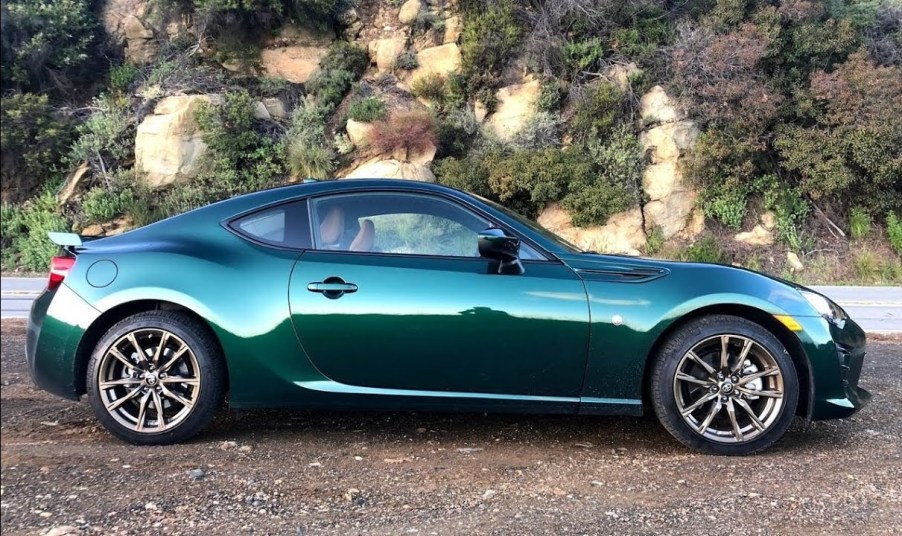
The Toyota 86 Is More Than the Sum of Its Parts
Although the Mazda Miata is often the go-to affordable sports car, there are other options. Most notably, the Subaru BRZ and its cross-town cousin, the Toyota 86. Taking its name from a beloved performance icon (and Initial D star), the 86 was Toyota’s sole sports car until the Supra returned. But despite the Supra’s speed, the 86 stands on its own in spite, or perhaps because of, its relatively-humble specs.
Toyota 86 lineup and specs

Every model in the Toyota 86 lineup gets the same 2.0-liter flat-four engine. Equipped with the optional automatic, it makes 200 hp and 151 lb-ft. With the standard 6-speed manual, that gets bumped to 205 hp and 156 lb-ft.

Although each 86 gets a 7” touchscreen infotainment with Apple CarPlay and Android Auto, you won’t find driver-assistance features like lane-keeping assist or blind-spot monitoring in the options list. You will, however, find a TRD handling package, which includes Sachs dampers, bigger brakes with Brembo calipers, 18” alloy wheels, and Michelin Pilot Sport 4 tires. And, unlike the Miata, the Toyota 86 has foldable rear seats. The 86 also has a larger trunk than the Miata.

Currently, the Toyota 86 is available in 3 trims: the $27,060 base model, $29,910 GT, and the $29,870 Hakone Edition. Although the Hakone Edition does come with an exclusive paint color, bronze wheels, and upgraded interior, it’s mostly a cosmetics package. Car and Driver recommends sticking with the GT and adding the $1195 TRD package.
How it stands out from the competition
In his review of the Toyota 86 Hakone on The Smoking Tire, presenter Zack Klapman acknowledged the car’s power deficit.

For about $3000 more than the 86, someone could buy a V6 Chevy Camaro 1LE, which Road & Track called “a track-ready sports-car bargain.” Or, the Ford Mustang EcoBoost with Performance Pack. The former has a 335-hp 3.6-liter V6, and the latter a 332-hp 2.3-liter turbocharged four-cylinder.

Making matters worse is the Toyota 86 has a pronounced ‘dip’ in its torque curve. Around 4000 RPM, the car feels like it’s running out of steam, despite continuing to accelerate. However, R&T reports the dip can be eliminated with careful tuning. And, as Engineering Explained’s Jason Fenske and Klapman explain, that’s not what the 86 is about.
The Toyota 86 got that flat-four engine because it made for a lower center of gravity. That, plus the car’s wide track, makes it both stable and extremely maneuverable. Then there’s the chassis, suspension, and steering tuning. The car is able to clearly communicate the level of grip at each wheel, through the driver’s seat and the steering wheel. You’re never nervous in the Toyota 86 because you’re always aware of what the car’s doing beneath you.

The 86 can also be a fairly-good commuter. The ride is surprisingly good, and Klapman was able to beat the car’s EPA highway rating. Some of the interior materials are a little cheap, but that also means the car has low operating costs. And if something does go wrong, there’s a strong aftermarket community there to help you fix and improve it.
Oh, and as for that lack of power? We believe Toyota has indeed been listening to customer complaints.
The Toyota 86 will continue
Recently, news leaked of Toyota’s upcoming product plans. Among them was an updated version of the Toyota 86, now called the GR86, after Toyota’s Gazoo Racing division. To be sure, The Drive reports the Toyota 86 and Subaru BRZ were not dead in the water after the current generation wrapped up. However, this new leak claims the updated models would receive some notable upgrades.
The next-gen 86 will still share a platform with the BRZ, The Drive reports, but each car will receive a new interior with improved materials. More importantly, the sports cars will receive more power, in the form of a 255-hp turbocharged engine.
Seems like the Eurobeat will indeed intensify.
Follow more updates from MotorBiscuit on our Facebook page.


